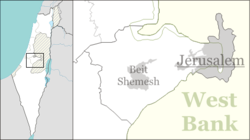Nehusha (Hebrew: נְחוּשָׁה, lit. 'Steadfast') is a moshav in central Israel. Located five kilometres north-east of Beit Guvrin, it falls under the jurisdiction of Mateh Yehuda Regional Council. In 2022 it had a population of 1,460.[1]
Nehusha
נְחוּשָׁה | |
|---|---|
 Nehusha seen from the hill of Khirbat Umm Burj | |
| Coordinates: 31°37′43″N 34°57′8″E / 31.62861°N 34.95222°E | |
| Country | Israel |
| District | Jerusalem |
| Council | Mateh Yehuda |
| Affiliation | Hapoel HaMizrachi |
| Founded | 1955 |
| Population (2022)[1] | 1,460 |
| Website | www.nechusha.org.il |
History
editThe moshav was established in 1955 on the land of the depopulated Palestinian village of Umm Burj.[2] but collapsed in 1968. It was re-established in 1981. Its name is derived from the name of the Biblical town of Ir-Nachash (1 Chronicles 4:12)[3] nearby and from Psalms 18:35 (where it is translated as brass, although its meaning is steadfast or firm);
Who traineth my hands for war, so that mine arms do bend a bow of brass.
Archaeology
editIn 2004 an archaeological excavation was conducted at Nehusha by Rona Avissar on behalf of Bar Ilan University's Department of Land of Israel Studies and Archaeology.[4]
The excavation revealed about 30 entrances to rock-cut caves, 10 bell shaped caves with plastered walls, rock-cut tombs with kokhim, columbarium, agricultural facilities later to become an underground hiding complex and a stable. Pottery fragments at the site dates back to the Hasmonean dynasty, Roman and Byzantine periods and very few from the medieval period. [5]
Gallery
edit-
The ancient ruin of Qayit, near Nehusha
-
Ruin of Qayit near Moshav Nehusha
-
Ruin of Qayit near Nehusha
References
edit- ^ a b "Regional Statistics". Israel Central Bureau of Statistics. Retrieved 21 March 2024.
- ^ Khalidi, Walid (1992), All That Remains: The Palestinian Villages Occupied and Depopulated by Israel in 1948, Washington D.C.: Institute for Palestine Studies, pp. 217, 224, ISBN 0-88728-224-5,
- ^ Carta's Official Guide to Israel and Complete Gazetteer to all Sites in the Holy Land. (3rd edition 1993) Jerusalem, Carta, p. 361, ISBN 965-220-186-3 (English)
- ^ Israel Antiquities Authority, Excavators and Excavations Permit for Year 2004, Survey Permit # B-283
- ^ "גיליון 116 לשנת 2004חורבת קיט". www.hadashot-esi.org.il. Retrieved 2024-03-24.
External links
edit- Village website (in Hebrew)
